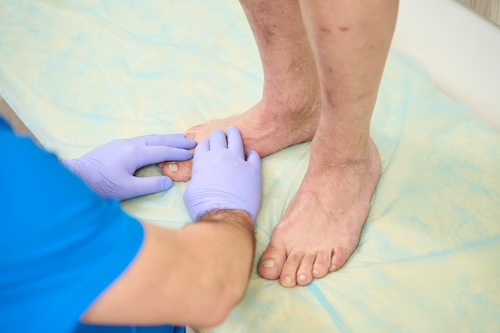Diabetes affects millions of people worldwide, and while much attention is given to blood sugar management, foot health is often overlooked. However, diabetes can have serious consequences for the feet, making regular foot care essential. Understanding the connection between diabetes and foot health can help prevent complications and ensure long-term mobility.
How Does Diabetes Affect Your Feet?
Diabetes impacts foot health in several ways, primarily due to nerve damage (neuropathy) and poor circulation:
- Diabetic Neuropathy – High blood sugar levels over time can damage nerves in the feet, reducing sensation. This means minor cuts, blisters, or injuries may go unnoticed, increasing the risk of infections.
- Poor Circulation (Peripheral Artery Disease) – Diabetes can narrow blood vessels, reducing blood flow to the feet. This slows healing and increases the risk of ulcers, infections, and in severe cases, amputation.
- Increased Risk of Infections – A weakened immune system makes diabetics more prone to fungal infections, foot ulcers, and complications from minor wounds.
Warning Signs to Watch For
It’s important for diabetics to check their feet daily and watch for these symptoms:
✅ Numbness or tingling sensation
✅ Unexplained pain or burning
✅ Slow-healing cuts or sores
✅ Changes in skin color or temperature
✅ Redness, swelling, or foul odor
If any of these symptoms appear, seeing a podiatrist promptly is crucial.

The Importance of Regular Foot Checkups
Routine foot exams by a podiatrist help detect problems early and prevent serious complications. The American Diabetes Association recommends annual foot exams, or more frequently for those with existing foot issues.
During a checkup, your podiatrist will:
- Assess circulation and nerve function
- Check for ulcers, infections, or pressure points
- Trim nails properly to prevent ingrown toenails
- Provide advice on proper footwear and foot care

Essential Prevention Tips for Diabetic Foot Health
🦶 Inspect Your Feet Daily – Look for cuts, blisters, or swelling. Use a mirror if needed.
🦶 Keep Your Feet Clean & Moisturized – Wash daily and apply lotion (but avoid between the toes).
🦶 Trim Nails Carefully – Cut straight across to prevent ingrown toenails.
🦶 Always Wear Proper Footwear – Avoid walking barefoot; choose supportive, well-fitted shoes.
🦶 Manage Blood Sugar Levels – Keeping diabetes under control improves circulation and nerve health.
🦶 Exercise Regularly – Gentle foot and leg exercises help maintain blood flow.
🦶 Avoid Smoking – Smoking worsens circulation, increasing the risk of foot complications.

Diabetes & Foot Health: Key Statistics
- Risk of Amputation
- 20% of hospitalizations among people with diabetes are due to foot problems.
- People with diabetes are 10 times more likely to require a lower-limb amputation than those without diabetes.
- 85% of diabetes-related amputations start with a foot ulcer.
- Source: American Diabetes Association
- Diabetic Foot Ulcers & Healing
- 15% of people with diabetes will develop a foot ulcer at some point.
- 50% of diabetic foot ulcers become infected, increasing the risk of severe complications.
- Up to 80% of diabetic foot ulcers that lead to amputations could have been prevented with early intervention.
- Source: National Library of Medicine
- Preventive Care Impact
Success Story: Preventing Amputation with Proper Diabetic Foot Care
John, a 58-year-old man with type 2 diabetes, had been struggling with numbness and tingling in his feet for years. He ignored a small blister on his toe, thinking it would heal on its own. Within weeks, the wound became infected, and his doctor warned that without proper care, amputation might be necessary.
Fortunately, John sought help from a podiatrist who specialized in diabetic foot care. With aggressive wound treatment, custom orthotics, and daily foot monitoring, he was able to heal completely without surgery. Today, he follows a strict foot care routine, wears specialized diabetic shoes, and sees his podiatrist regularly—proving that early intervention can prevent severe complications.
Helpful Links
- American Podiatric Medical Association – Diabetic Foot Care – Information on prevention, footwear, and warning signs.
- CDC – Diabetes and Your Feet – Guidelines on daily foot care routines.
- Mayo Clinic – Diabetic Neuropathy – Symptoms and treatment options.
Conclusion
Diabetes-related foot problems can be serious, but they are also highly preventable. By practicing daily foot care, wearing proper footwear, and scheduling regular checkups, individuals with diabetes can significantly reduce their risk of complications.
If you have diabetes, don’t wait for symptoms to appear—schedule a foot health checkup today with Podiatry of Greater Cleveland and take proactive steps toward healthier feet!
📞 Call us at (440) 884-4100 or visit our website at clevelandfoot.com to book your appointment!

